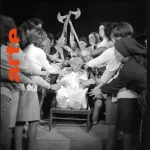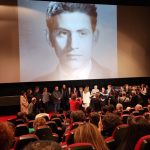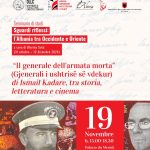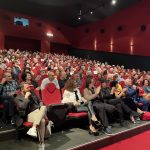| Reference Code | I/2-117 |
| Title | Renaissance |
| Synopsis | Mountains and valleys sceneries in winter. Poor peasants, clouds, a small beggar begging. A young coachman, imam going to the mosque and a man praying. A strong worker works in rock, mine explosion and actress Roza Xhuxha reciting. The film starts with the book of poems written by Llazar Siliqi. A child lying in the cradle, I took him upside down, but he looks at the ceiling, hanging miserably. A rifle hanging on the wall and a cow. A window of the house from which light enters. The light does not shine through the small window. This was brought by the partisans who gave their lives. A partisan grave, on whose stone is hung a necklace of bullets. A farmer works holding a rifle in his arms. Workers are cutting wood; others are building houses and Lenin’s photo is dispalyed on the screen. Tractors coming from Russia are unloaded at the port of Durres by the peasants who transport products with donkeys. Young people working on the railway; the train passes over the tracks. (291) A mountain girl reading, together with many other children going to school, walking on bumpy road, crossing the river. This is their school. Children write the name of their teacher, Ndrek Ndue Gjoka on the board. Gunshots are heard and the books are scattered. The children go down the stairs and run to the scene. Photo of teacher Ndrek Ndue Gjoka. Young people who enter and leave the university, the bust of Naim Frasheri, engineer and chemist staff at the laboratory, high voltage engineer, etc. Painter Wilson Kilian painting still nature. Tish Daija composes. Kujtim Spahivogli prepares for the role of Hamlet. Tirana is changing, the train with young people passes by, beautiful young men and women. Children on the street and Lenin’s monument. (216. 70) Starts with detonation of mines, tractor in the field, cable car plans, high voltage poles and well 542. Short-range footage of all sectors of industry and construction. Stopping the American aeroplane which is forced to land in our field. Parachutes of saboteurs who appear before the court. Squad of monarcho-fascists throwing stones. An old mountaineer at a grave and the guard of the border. (221. 10) The parade on a May day. A martyr’s mother looks at the photograph of her martyred son. Young people with flowers parading. Fireworks exploding in the evening. Artist Kujtim Spahivogli reciting, mountaineers listening to the veteran. An old boat, a dinner at the palace of Zogu. Zogu passes with his sister. Count Ciano comes to Albania. Kujtim Spahivogli reciting. Images from the past. A loaded porter crashes and falls to the ground. Partisan Mentor Xhemali singing with Jorgjie Velo at the opera. An officer sees the concert and remembers the partisans. (231. 70) Begins with the panorama of the valley, a geologist observing, and a shepherd plays the flute. Children playing with balloons while the bar carts passing by. The tractor harvests the grain that is spilled from the machine. Berat leandscapes, the sea, Butrinti, a fishing motorboat and prominent personalities such as Sterio Spase, Kristaq Antoniu. The blind philologist dictates to the secretary who writes. Martyr’s mother watering the flowers, the grave of the partisan with a belt of cartridges, the mother rocking the child in the cradle, the farmer working the land , the old school and the kindergarten children accompanied by beautiful landscapes, factories, flowers. (155. 80) |
| Awards | |
| Screenwriter | Endri Keko Llazar Siliqi |
| Scriptwriter | Llazar Siliqi |
| Director | Endri Keko Xhanfize Keko |
| Composer | Preng Jakova (formulim) |
| Camera | Sokrat Musha Petraq Lubonja |
| Designer | |
| Editing | |
| Sound | |
| Category | Documentaries |
| Chroma | |
| Year | 1961 |
| Release date | 1961 |
| Reels | 5 |
| Lenght (in minutes) | 37 |
| Country of origin | Shqiperi |
| Shooting locations | |
| Producers | |
| Notes | |
| © Copyright | Arkivi Qendror Shtetëror i Filmit |
Share This Article




